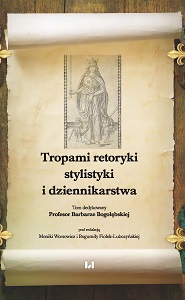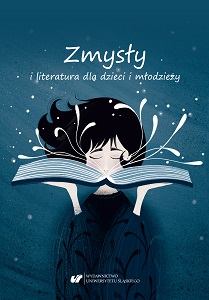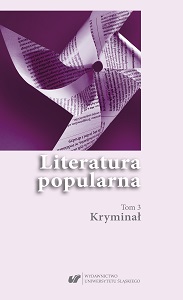
We kindly inform you that, as long as the subject affiliation of our 300.000+ articles is in progress, you might get unsufficient or no results on your third level or second level search. In this case, please broaden your search criteria.



The author of the article, assuming that the child experiences the world through the senses, indicates the specificity of the sense of touch and its role in the communication of the child. Then, she shows that the atypicality and richness of tactile sensations is reflected in semantics and lexicon of the Polish language. Also language metaphors, especially of the synesthetic variety, reflect the sense of touch. As a proof of foregoing the author cites the conclusions from the research carried out on synesthetic metaphors drawn from the texts for children and adoelscents. The conclusions point to the essential role of the sense of touch in learning about the world, reflected in the language: it is a significant domain carrying a huge number of metaphorical extensions defining broadly understood contact in communication.
More...
The article discusses issues of interactivity in books for children and adolescents. It presents the basic characteristics of interactivity based on typology suggested by Eric Zimmerman (cognitive interactivity, functional interactivity, explicit interactivity and meta-interactivity), then confronts them with examples of selected titles of toy books, converged books, and game books. Article is also an attempt to show the changes in the way that publishers communicate with their readers.
More...
The author argues that touch is one of the primary ways for children to feel the world, and that is why it also plays such an important role in literature written for children. The researcher, by referring to the Scandinavian idea of anti-pedagogy, presents how the problem of bad touch works in contemporary separate literature and how one, during contact with this type of books, can sensitize a child to evil.
More...
Scholars agree that description of smells in literature is an especially challenging task. But at the same time it is proved that the sense of smell (and taste) is capable of evoking childhood memories most powerfully. So the attempt to depict childhood memories should be also the attempt to describe the particular “olfactory landscapes” connected with this period of human life.The author of the article tries to answer the question if and how the writers of children’s poems and prose (mainly autobiographical one) in the 21st century depict olfactory senses. The paper is divided into four parts, referring to the ways of depicting scents that are usually associated with childhood: food, home, backyard, outside spaces, and nature. This is an introductory article that precedes broader and deeper text, which shall draw on more examples from contemporary children’s literature.
More...
The author considers the concept of “living being” which is born in the consciousness of the recipient during the act of reading. It is, according to the researcher, proposed by the text, but it is not only in the text, in some part of it is also in the recipient. In the article on the literary material (prose works of Justyna Bednarek), it is shown how the sensuality of a literary character influences his or her “literary life” and allows him or her to materialize in the consciousness of the reader. The individual characters of the text entitled Mr Kardan and the adventure with vetustas are here analyzed for their sensuality and the possibility of literature reception by the child. The researcher draws attention to the type of a character, the situation in which she is found, a feature outline, as well as the narrative method appropriate for the mentioned writer. It assumes that the sensuality of the character, its corporeality in the aspect of somaticity, is what makes him or her a being that lives in the reader.
More...
Zofia Kossak, an outstanding novelist and what is less known – a painter, whom fate cast on Cieszyn Silesia, told the youngest readers about the beauty of this land in an excellent fairy tale entitled Kłopoty Kacperka, góreckiego skrzata (“Troubles of Kacperek, a Dwarf from Górki”). It is completely embedded in the Beskid landscape realities. In the mountainous landscape of Górki Wielkie there is a fight between good and evil, and in accordance with the convention of fairy tales, good prevails. The beauty of the text is determined by its painterliness and sensuality, which are probably the result of the writer’s fascination with the Silesian Beskids. For her, the mountains were the most perfect landscape.
More...
The author analyses the presentations of multi-sensual experience in the interwar period literature about sport and nature, designed for young readers, on the example of the works by Jerzy and Helena Rytard as well as Józef Bieniasz. She claims that the knowledge about the external reality, which one gathers empirically, was an essential tool for the understanding of others. This type of knowledge determined numerous models and antimodels of behaviour, attitudes and beliefs. The sensual experience of the space of winter mountains was probably less important and it was used to illustrate the influence of cultural changes on the reliability (authority) of experience. The novels in question deeply affected the emotions of young characters and proved that man’s life is enriched thanks to nature, but it is also impoverished due to civilizational expansion. Novels about skiing illustrate this problem deeply and profoundly due to the fact that it allowed the readers to have an insight into the multi-sensual experience. A rich educational potential of the novels by the Rytards and by Bieniasz was fully actualized thanks to various techniques of discovering and experiencing Beauty, the mysteries of nature and the manifestations of its life, as well as to the broadly-based somatic experience of the skiers in their perception of kinaesthetic space.
More...
The volume of poems Dębowa kołyska, published in 1967, combines rural and children’s folklore. This convention also includes illustrations by Adam Kilian, characterized by artistic primitivism. The collection read as a whole, as well as in a situation where the recipient is a child of pre-school age, most fully reveals its virtues of sensual and literary-graphical design. The poet’s works are reactive, appeal to the many senses of the youngest reader, engage his/her body, memory and imagination; stimulate multidirectional reading that is open to gesture and movement, rhythm and aesthetics of repetition, audio-description of the world; relate to the taste and smell of food. At the same time, they pursue the idea of children’s vitalism through topics related to the close environment of the child (family, home, fun, everyday activities) and heterogeneity of children’s statements (nursery rhymes, lullabies, counts, riddles, “ifbugs”). Kamieńska saw the cultural and educational need for intergenerational transmission in the functional, objective and subjective aspect. This is evidenced by the situational-utilitarian character of the poems from Dębowa kołyska, their formal-linguistic formation, the author’s knowledge of the stages of childhood development and her belief in the “phylogenetic” priority of direct contact before indirect and remote, joint reading before attempts of independent reading, orality before writing, from today’s perspective, one can also add – both these forms of transmission before using electronic devices. The poet expresses these issues with the motto that begins the collection: “Róża nie zakwitnie, jak się nie polewa. / Dziecko nie urośnie, jak mu się nie śpiewa” (‘The rose will not blossom if it isn’t watered. / The child will not grow up if they don’t sing for him/her”).
More...
The author of the article argues that the richness of the phonic values of children’s poetry can be considered its primary feature thanks to which it reaches a pre-literate child and shapes their imagination and musical sensitivity. The researcher quoting the poems in question proves that thanks to the incredible sense of melody and rhythm of youngest children, as well as the poets’ undertaking of musical themes and the development of the acoustic sphere of children’s poetry, it is possible to bring together two arts that composed a whole in ancient times: poetry and music.
More...
Combining the traditional, realistic techniques of depicting the hero’s image with an in-depth inner biography is undoubtedly one of the most important achievements of prose by Irena Jurgielewiczowa. The writer utilizes the technique that the author of the article calls “visual thinking”. Seeing, perceiving, sense of sight, and looking at things are decisive in the construction of interpersonal narrative relationships, as well as in the description of the character. The main characters of the most important works by Jurgielewiczowa have the gift of observation, they are at the same time observing, being looked at and surreptitiously watched. A glance is a source of knowledge about characters because it expresses personality traits, emotions, and awareness of one’s own position. The subject of the article is a specific “poetics of sight,” visuality and visibility as the properties of Jurgielewiczowa’s writing practice. Referring to somapoetics, the author discusses the functionality of the categories of corporeality, body and physiognomy in the (re)interpretation of the prose of this outstanding, though somewhat forgotten prose.
More...

In the interwar period, the school was supported by numerous institutions and societies in its exceptional educational tasks at that time. Among them – the Polish Country- Lovers’ Society, which by publishing specialized magazines, provided teachers with methodological help. The aim of the article was to analyze selected press statements published in the pages of Orli Lot (Eagle’s Flight) – one of the most important tourist and travel magazines for between 1918 and 1939. By utilizing the tools of the press content analysis and geo-criticism method, it was proved that images of feelings associated with sensual perception of a given space dominated in descriptions of various landscapes. In addition to the cognitive function, descriptions of landscapes composed in such a way fulfilled an educational function, as they perpetuated in the minds of readers not so much the realistic as imaginary (subordinated to the idea or ideology) image of a given space, region, land.
More...
The article is an attempt to show the ritual of dining as a tool of oppression applied to children. Literature aimed at children tries to help them overcome the trauma of eating process by showing culinary experience as a social event, which is the beginning of reflection on freedom, possibilities of making choices or building one’s own identity. According to the author the collection of poems by Natalia Usenko serves that purpose.
More...
The article is focused on the analysis of the concept of multimodality in crime fiction, providing an outline of the multitude of the utilized narrative devices. This various aspects of multimodality are studied in visual (typography, layout, illustrations, binding, composition), audial or diegetic context, as well as in the ways the narrative may be focalized. This predominantly aesthetic components are not merely illustrating the plot, but serve as vehicles for world‑building as they contribute for constructing credible and immersive storyworlds. The exemplified works of crime fiction, both founding for the genre, and more contemporaneous, are viewed as relevant for postclassical narrative studies which therefore allows for revising the structural stereotypes of crime fiction from 60s.
More...
The main topic of the article is to show influence of Auguste Dupin and Sherlock Holmes, two most popular fictional XIXth century detectives (created by E.A. Poe and A.C. Doyle) on genre developement. The author characterises protagonists and describes how their features has become parts of literary detective category. What is more, she shows difference in heroes’ creation, which eventually let Sherlock Holmes be the detective’s archetype. In the articles terms from sociology of literature were used, especially those from reception theory by Marcin Rychlewski – division for transfer and esthetic zone.
More...![„[…] fałszywe tropy, zwodnicze, mylące pociągnięcia tego, kto stał niewidzialny, za całą tą sprawą”. Poetyka kryminału w Przyjacielu Stanisława Lema](/api/image/getbookcoverimage?id=document_cover-page-image_874766.jpg)
The article deals with the specificity of crime novels by Stanislaw Lem and presents the analysis of his short story Friend. The text begins with Lem’s views on contemporary crime stories and puts forward a most appropriate shape, which – in Lem’s opinion – model detective stories should take. After the presentation of the research conducted on Lem’s crime novels, I proceed to analyse Friend, the text that bears imprints of Lem’s future anti‑crime stories as well as displays certain relation with deconstruction.
More...
The article deals with the book series written by Zbigniew Białas referred to as “Sosnowiec chronicles”, which were announced in the years 2011–2015. The writer employed some elements belonging to the convention of the urban vintage crime fiction, especially in the first and second parts of the trilogy. The author of the article reflects on the usefulness of the solutions employed by the writer, inquiring what he has achieved with them, how he has modelled the plot, and what prompted him to choose the formula of the historical detective novel as a matrix. These considerations are embedded in a broader genological context. Also, the author discusses the career of a sub‑genre of contemporary crime fiction initiated by Marek Krajewski’s first novel and its transformations, as well as critical literary reactions to this sub‑genre. The author pays special attention to the links between the urban vintage crime fiction and the so‑called literature of little homelands, a trend that dominated the Polish literature of the 1990s. He asks about the possibility of literary „splendouring” of urban space, demonstrating various solutions in this matter. At the same time, he reflects on socio‑literary transformations, pointing out that the authors of vintage crime novels – with few exceptions – have enjoyed only local fame, and their works seem to have been a response to local needs, often associated with the promotion of particular cities. Then he presents the image of the city (Sosnowiec) which emerges from Białas’s trilogy, focusing on the differences in the approach to spatial issues that are observed in the three subsequent volumes. At the end of the article, the author wonders about the perspectives of the story about Sosnowiec.
More...
The main aim of the article is the interpretation of the works written by Ryszard Ćwirlej in the 21st century, in the years 2007–2016. The series of crime fiction novels shows investigations conducted by the Citizen’s Militia officers in Poznań in the 1980s, during martial law and a few years later. However, in Ćwirlej’s work, the history of the Wielkopolska community during the declining period of the People’s Republic of Poland is more important. Numerous images of the regional variation of those collective experiences and (too) many portraits of the inhabitants of the Polish province are the features that distinguish the author from many other contemporary writers of crime fiction.
More...